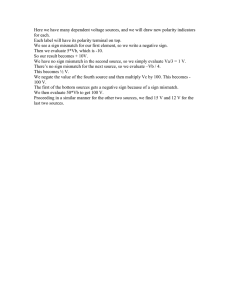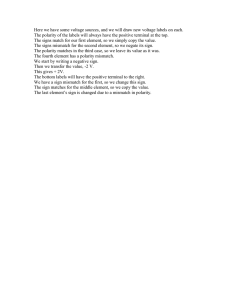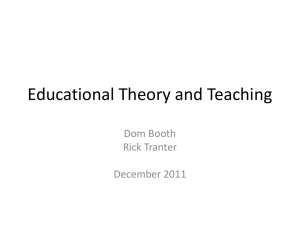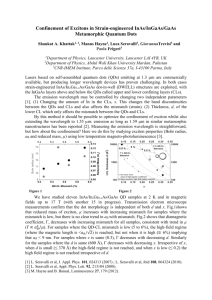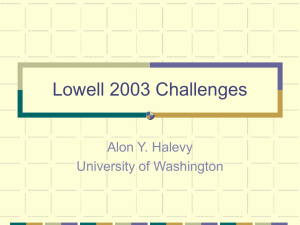THE SYSTEM LEVEL CAUSES AND CONSEQUENCES OF FIELD OF STUDY MISMATCH
advertisement
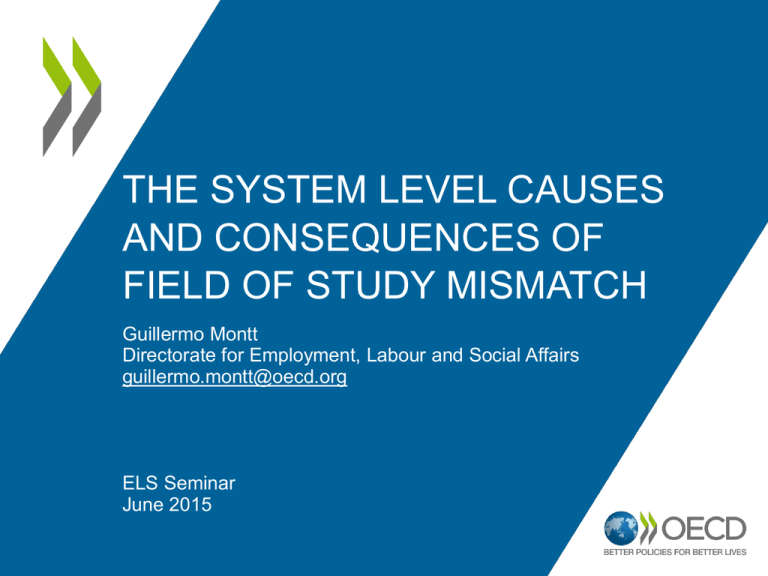
THE SYSTEM LEVEL CAUSES AND CONSEQUENCES OF FIELD OF STUDY MISMATCH Guillermo Montt Directorate for Employment, Labour and Social Affairs guillermo.montt@oecd.org ELS Seminar June 2015 What is field-of-study mismatch? • Theory: workers trained in a field but working in another, unrelated sector E.g. • a pharmaceutical technician (ISCO 321) is matched if studied science or health • a ship and aircraft controller and technician (ISCO 325) if studied engineering only “English Lit – How about you?” • Operational definition Eight fields of study: 1) General programmes 2) Teaching and education Humanities, In3)PIAAC, if anlanguages, individualarts 4) Social sciences, business, law works in an occupation that 5) Science, mathematics, does not correspond to its computing field of study, the worker is 6) Engineering, construction, manufacturing considered mismatched by 7) Agriculture field of study and veterinary 8) Health and welfare 9) Services Each ISCO_08 3-digit occupations matched to each field (one or more) Why should we care about studying fieldof-study mismatch? • Existing evidence: – For workers it brings lower wages, lower job satisfaction, higher on-the-job search – More likely in certain fields than others (humanities, languages and arts vs. health and welfare) • Gaps in the literature: • Updated cross-national levels and effects of FoS mismatch on individual outcomes • Relationship to other forms of mismatch • Relationship to labour market dynamics • System-level costs of FoS mismatch Should we care and/or do anything about field of study mismatch? Data and methods • PIAAC Survey of Adult Skills, 2012 • Data for 24 countries • Cross-country and pooled-sample analysis – Pooled analysis rescales weights to consider each country as a unit • All analyses (OLS, logit, path analysis) consider replicate weights and plausible values (where applicable) Source: Survey of Adult Skills (PIAAC) (2012). Finland Germany Austria Norway Sweden Netherlands Denmark Estonia Canada Slovak Republic Czech Republic Country Average Flanders (Belgium) Poland Ireland Russian Federation France Spain United States 60% Japan Australia Italy England/N. Ireland (UK) Korea How much field-of-study mismatch is there? Percentage of workers mismatched by field-of-study 50% 40% 30% 20% 10% 0% How much field-of-study mismatch is there? For a given group of graduates by field For a given group of workers by occupation (2) Teacher training and education science (3) Humanities, languages and arts (4) Social sciences, business and law (5) Science, mathematics and computing More than (6) Engineering, manufacturing and 40% of workers in the construction services sector come from other >70% of graduates from (7) Agriculture andfields. veterinary humanities, languages and (8) Health and welfare arts end up working in another sector (9) Service 100% 80% 60% 40% 20% 0% 0% 20% 40% 60% 80% 100% Note: Cross-country averages. Source: Survey of Adult Skills (PIAAC) (2012). How much field-of-study mismatch is half is In some countries around associated with qualifications qualifications mismatch? Field-of-study, qualifications and mismatch skills mismatch >50% field of study Field-of-study and skills mismatch is independent of skills or 100% mismatch (usually overqualification) Field-of-study and qualifications mismatch Field-of-study mismatch only qualifications mismatch 80% 60% 40% 20% Source: Survey of Adult Skills (PIAAC) (2012). Spain Ireland Italy England/N. Ireland (UK) Austria Canada France Japan Germany Norway Sweden Australia Country Average United States Estonia Russian Federation Denmark Czech Republic Korea Netherlands Finland Flanders (Belgium) Poland Slovak Republic 0% What causes field-of-study mismatch? • Saturation: there are too many graduates from this field and fewer jobs in the corresponding sector – Roughly: Number of graduates from the field Number of workers in that sector (for more details, click HERE) • Skill transferability: skills from the field are transferrable / valued in other sectors – Roughly: Number of skills well-matched in that sector Number of FoS mismatched in that sector (for more details, click HERE) Does saturation and transferability predict field of study mismatch? The short answer: YES Graduates from more saturated fields are more likely to be mismatched (and overqualified) Graduates from fields with more transferability are more likely to be mismatched and well qualified Results hold within countries as well Note: Path analysis with country fixed effects. Source: Survey of Adult Skills (PIAAC) (2012). Does field-of-study mismatch imply a wage penalty? The short answer: Yes, when it also involves overqualification Field-of-study alone carries a penalty only in England/N. Ireland (UK) (6%), Ireland (11%) and Estonia (8%) Note: Path analysis with country fixed effects. Source: Survey of Adult Skills (PIAAC) (2012). The penalty varies by field Intercept Field of study mismatch only x Skill transferability x Major: (2) Teaching x Major: (3) Humanities x Major: (4) Social sciences x Major: (5) Sciences x Major: (6) Engineering x Major: (7) Agriculture x Major: (8) Health Field of study mismatch and overqualification x Skill transferability x Major: (2) Teaching x Major: (3) Humanities x Major: (4) Social sciences x Major: (5) Sciences x Major: (6) Engineering x Major: (7) Agriculture x Major: (8) Health Beta 2.46 *** 0.05 ** S.E. (0.05) (0.02) -0.09 ** -0.06 * -0.11 *** -0.07 ** -0.04 * 0.07 -0.04 (0.03) (0.03) (0.02) (0.02) (0.02) (0.04) (0.02) -0.04 * (0.02) -0.24 *** -0.22 *** -0.25 *** -0.23 *** -0.21 *** -0.02 -0.20 *** (0.03) (0.03) (0.03) (0.03) (0.03) (0.04) (0.03) The penalty is stronger when there is overqualification, particularly for Teaching, Humanities, Social Sciences, Sciences and Engineering Linear regression with log(wages) as dependent variable. Services is the reference category for field of study. Models control for age, experience, tenure, contract type, public/private, firm size, numeracy, education level. Source: Survey of Adult Skills (PIAAC) (2012) Does field-of-study impact the risk of being out of work and job satisfaction? • Previously mismatched by field of study are more likely than previously well matched workers to be unemployed or inactive (18% vs. 14%) – Significant in 17/22 countries – ESP, KOR, NOR, USA: FoS mismatched workers have over twice the odds of being unemployed or inactive – Once out of work, previously mismatched workers do not spend more time out of work • Job satisfaction is generally high (79%). FoS mismatched are less satisfied only if FoS mismatch implies overqualification – It remains significant in CAN, FIN, KOR, USA after accounting for overqualification What are the costs of field-of-study mismatch to countries? • Potential sources of costs: – Losses in productivity (reflected in lower wages earned by mismatched individuals) – Sunk education costs – Higher unemployment benefits and lost income tax revenues • Total cost depends on – Number of mismatched individuals – Effect of mismatch The cost of field-of-study mismatch can from Highest share of costs comes amount to more than 1% ofcosts GDP(wages), most productivity of which result from the overqualification associated to Productivity Education Unemployment FoS mismatch (assumes a 50week work year) Percentage of GDP 3.0% 2.5% 2.0% Sunk education costs assume that “lost” education amounts to ½ a year for ISCED 3 and 1 year for ISCED 5. 1.5% 1.0% 0.5% 0.0% Finland Norway Sweden France Denmark Austria Flanders (Belgium) Italy Japan Netherlands Czech Republic Country Average Spain Slovak Republic Ireland Poland Korea England/N. Ireland (UK) -0.5% The take-away point • FoS mismatch results from labour market dynamics (saturation / shortage) and programme characteristics (skill transferability) • FoS mismatch is costly for individuals inasmuch it is a source of over-qualification • Its costs (when it leads to overqualification) can aggregate to important national-level costs in terms of productivity and sunk education costs “But Michael, the labour market is awaiting you!” The recommendations • Promote linkage between education provision and labour market needs – Skills assessment and anticipation systems linked to the definition of vacancies • Promote skill transferability so that FoS mismatch does not bring about over-qualification – Competency-based occupational frameworks – Flexible re-skilling programmes – General education • Forcing match may not be a good idea given labour market dynamics Thank you Contact: guillermo.montt@oecd.org Read more about our work Follow us on Twitter: @OECD_Social Website: www.oecd.org/els Newsletter: www.oecd.org/els/newsletter Saturation • Logic: there are too many graduates from this field and fewer jobs in the corresponding sector – Saturation = Number of graduates from the field Number of workers in that sector – No one-to-one correspondence between field of study and sector – Standardised with a mean 0, SD 1 for all countryfield combinations – Positive values indicate saturation greater than on average across fields (back) Transferability • Logic: skills from the field are transferrable / valued in other sectors Transferability= Number of skills well-matched in that sector Number of FoS mismatched in that sector – No one-to-one correspondence between field of study and sector – Interpreted as percentage of field mismatched workers in the sector that are not skills mismatched (back)
